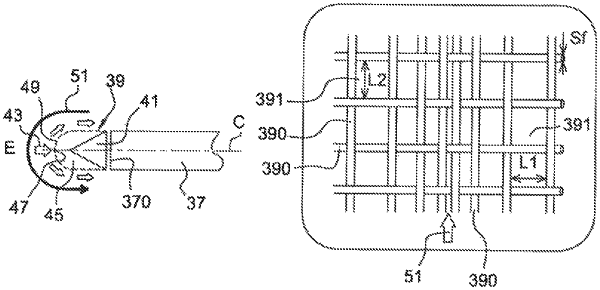| CPC F02C 7/045 (2013.01) [B64C 23/00 (2013.01); B64D 33/02 (2013.01); F02K 1/827 (2013.01); F02K 3/06 (2013.01); G10K 11/16 (2013.01); G10K 11/161 (2013.01); G10K 11/162 (2013.01); B64C 1/40 (2013.01); B64D 2033/0206 (2013.01); D06N 3/0006 (2013.01); D06N 2209/025 (2013.01); F02C 7/24 (2013.01); F05D 2220/323 (2013.01); F05D 2260/96 (2013.01); F05D 2300/514 (2013.01); F05D 2300/611 (2013.01)] | 18 Claims |

|
1. An acoustic attenuation edge designed to be installed on an aircraft turbine engine wall, in contact with a fluid flow, the acoustic attenuation edge comprising:
a porous coating (39) having a mesh structure,
an acoustically absorbent material (41) covered with the porous coating and having a first volume (Vabs), and
at least one cavity (45) located between the acoustically absorbent material (41) and the porous coating (39),
wherein the mesh structure has wires (390) separating between them mesh openings (391) passing through said mesh structure,
wherein:
each of the mesh openings (391) has an elementary surface area (So), some of the mesh openings (391) are large enough to include a circle 0.05 mm in diameter,
said at least one cavity (45) has a second volume (Vcav), as the second volume is higher than three percent of a sum of the first volume and the second volume (Vcav>3% (Vcav+Vabs)),
the fluid flow is to pass through the acoustic attenuation edge while propagating in a main propagation direction (43), the acoustic attenuation edge has a stop point (47) at which the fluid flow encounters the porous coating (39) and at which the main propagation direction (43) of said flow is normal to a front face of said porous coating (39) receiving said flow, and
the mesh openings are smaller near the stop point (47) than further away from said stop point.
|